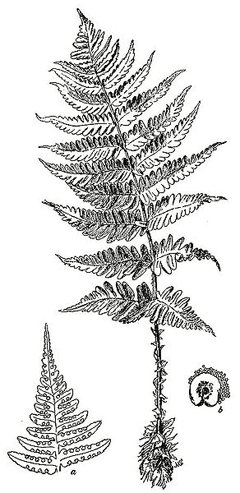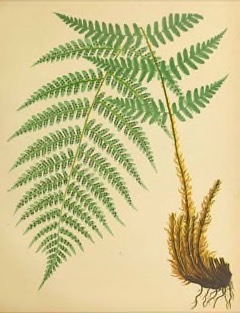 |
|
http://www.flickr.com/photos/28340342@N08/2979952446 |
 |
|
Translate this page:
Summary
Form: Irregular or sprawling, Spreading or horizontal, Upright or erect.
Physical Characteristics

 Dryopteris marginalis is an evergreen Fern growing to 0.8 m (2ft 7in) by 0.3 m (1ft) at a medium rate.
Dryopteris marginalis is an evergreen Fern growing to 0.8 m (2ft 7in) by 0.3 m (1ft) at a medium rate.
See above for USDA hardiness. It is hardy to UK zone 4. It is in leaf all year.
Suitable for: light (sandy), medium (loamy) and heavy (clay) soils. Suitable pH: mildly acid and neutral soils. It can grow in semi-shade (light woodland). It prefers moist soil and can tolerate drought.
UK Hardiness Map
US Hardiness Map
Synonyms
Plant Habitats
Woodland Garden Dappled Shade; Shady Edge;
Edible Uses
References More on Edible Uses
Medicinal Uses
Plants For A Future can not take any responsibility for any adverse effects from the use of plants. Always seek advice from a professional before using a plant medicinally.
Antirheumatic Odontalgic Vermifuge
The root contains ‘filicin’, a substance that paralyses tapeworms and other internal parasites and has been used as a worm expellent[171, 238]. It is one of the most effective treatments known for tapeworms - its use should be immediately followed by a non-oily purgative such as magnesium sulphate in order to expel the worms from the body[238]. An oily purge, such as caster oil, increases the absorption of the fern root and can be dangerous[238]. The root is harvested in the autumn and can be dried for later use, it should not be stored for longer than 12 months[238]. This remedy should be used with caution and only under the supervision of a qualified practitioner[238]. The root is toxic and the dosage is critical[238]. See also the notes above on toxicity. An infusion of the root has been used in the treatment of rheumatism[257]. A warm infusion, held in the mouth, has been used to treat toothaches[257].
References More on Medicinal Uses
The Bookshop: Edible Plant Books
Our Latest books on Perennial Plants For Food Forests and Permaculture Gardens in paperback or digital formats.

Edible Tropical Plants
Food Forest Plants for Hotter Conditions: 250+ Plants For Tropical Food Forests & Permaculture Gardens.
More

Edible Temperate Plants
Plants for Your Food Forest: 500 Plants for Temperate Food Forests & Permaculture Gardens.
More

More Books
PFAF have eight books available in paperback and digital formats. Browse the shop for more information.
Shop Now
Other Uses
References More on Other Uses
Cultivation details
Landscape Uses:Container, Ground cover, Specimen, Woodland garden. Prefers an acid to neutral soil, succeeding in ordinary fertile soil in a shady position. Succeeds in full sun but grows best in a shady position with only 2 - 3 hours sun per day[200]. Tolerates a pH range from 4.5 to 7[200]. Dislikes heavy clay. Prefers a good supply of water at its roots but succeeds in dry shade and tolerates drought when it is established. A very hardy plant, tolerating temperatures down to about -30°c[200]. Members of this genus are rarely if ever troubled by browsing deer[233]. Hybridizes in the wild with several other species[187]. Special Features:
Attractive foliage, North American native, Wetlands plant, There are no flowers or blooms. The plant is heat tolerant in zones 8 through 1. (Plant Hardiness Zones show how well plants withstand cold winter temperatures.
Plant Heat Zones show when plants would start suffering from the heat.
The Plant Heat Zone map is based on the number of "heat days" experienced in a given area where the temperature climbs to over 86 degrees F (30°C).
At this temperature, many plants begin to suffer physiological damage. Heat Zones range from 1 (no heat days) to 12 (210 or more heat days).
For example Heat Zone. 11-1 indicates that the plant is heat tolerant in zones 11 through 1.) For polyculture design as well as the above-ground architecture (form - tree, shrub etc. and size shown above) information on the habit and root pattern is also useful and given here if available. An evergreen. The plant growth habit is a clumper with limited spread [1-2]. The root pattern is rhizomatous with underground stems sending roots and shoots along their length [1-2].
References Carbon Farming Information and Carbon Sequestration Information
Temperature Converter
Type a value in the Celsius field to convert the value to Fahrenheit:
Fahrenheit:
The PFAF Bookshop
Plants For A Future have a number of books available in paperback and digital form. Book titles include Edible Plants, Edible Perennials, Edible Trees,Edible Shrubs, Woodland Gardening, and Temperate Food Forest Plants. Our new book is Food Forest Plants For Hotter Conditions (Tropical and Sub-Tropical).
Shop Now
Plant Propagation
Spores - can be sown at any time of the year in a greenhouse. Surface sow on a sterilised compost and keep moist, possibly by placing the pot in a plastic bag. Germinates in 1 - 3 months at 20°c. Pot up small clumps of the plants when they are large enough to handle and grow on in a shady part of the greenhouse until large enough to plant out. Division in spring. Larger clumps can be replanted direct into their permanent positions, though it is best to pot up smaller clumps and grow them on in a cold frame until they are rooting well. Plant them out in the spring.
Other Names
If available other names are mentioned here
Native Range
NORTHERN AMERICA: Greenland (southeast), Canada, Québec, Nova Scotia, Ontario, New Brunswick, Newfoundland and Labrador, United States, Connecticut, Indiana, Maine, Massachusetts, Michigan, New Hampshire, New Jersey, New York, Ohio, Pennsylvania, Rhode Island, Vermont, West Virginia, Illinois, Iowa (east), Kansas (east), Missouri, Oklahoma, Wisconsin, Alabama (north), Arkansas, Delaware, Georgia (north), Kentucky, Maryland, North Carolina (west), South Carolina, Tennessee, Virginia,
Weed Potential
Right plant wrong place. We are currently updating this section.
Please note that a plant may be invasive in one area but may not in your area so it's worth checking.
Conservation Status
IUCN Red List of Threatened Plants Status :

Growth: S = slow M = medium F = fast. Soil: L = light (sandy) M = medium H = heavy (clay). pH: A = acid N = neutral B = basic (alkaline). Shade: F = full shade S = semi-shade N = no shade. Moisture: D = dry M = Moist We = wet Wa = water.
Now available:
Food Forest Plants for Mediterranean Conditions
350+ Perennial Plants For Mediterranean and Drier Food Forests and Permaculture Gardens.
[Paperback and eBook]
This is the third in Plants For A Future's series of plant guides for food forests tailored to
specific climate zones. Following volumes on temperate and tropical ecosystems, this book focuses
on species suited to Mediterranean conditions—regions with hot, dry summers and cool, wet winters,
often facing the added challenge of climate change.
Read More
Expert comment
Author
(L.)A.Gray.
Botanical References
200270
Links / References
For a list of references used on this page please go here
Readers comment
| Add a comment |
|
If you have important information about this plant that may help other users please add a comment or link below. Only comments or links that are felt to be directly relevant to a plant will be included. If you think a comment/link or information contained on this page is inaccurate or misleading we would welcome your feedback at [email protected]. If you have questions about a plant please use the Forum on this website as we do not have the resources to answer questions ourselves.
* Please note: the comments by website users are not necessarily those held by PFAF and may give misleading or inaccurate information.
To leave a comment please Register or login here All comments need to be approved so will not appear immediately.
|
Subject : Dryopteris marginalis
|
|
|
|